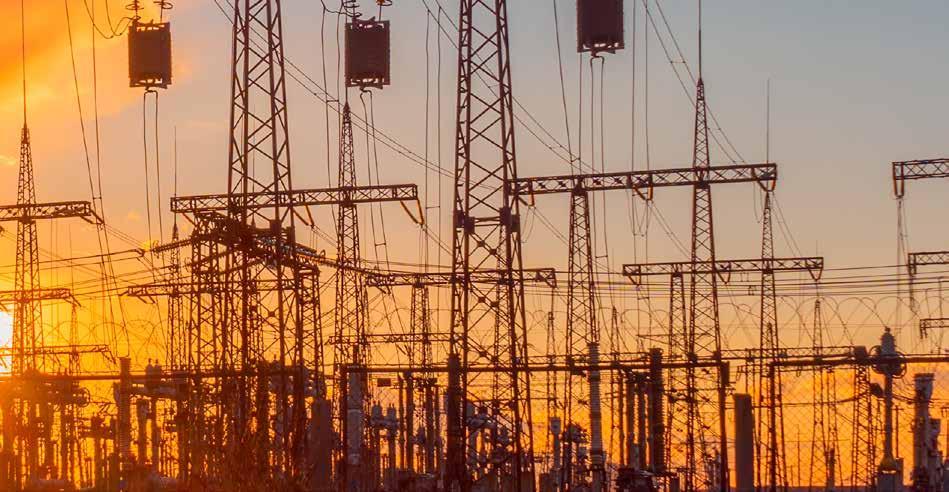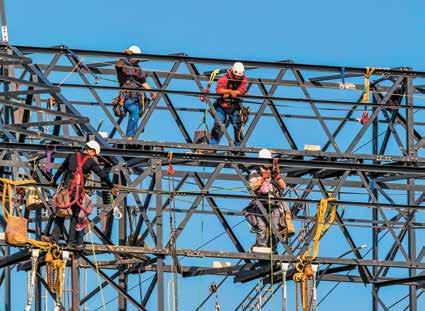
5 minute read
Código de Red, entre el
Elementos para impulsar la eficiencia y seguridad Elements to boost efficiency and safety
Código de Red, entre el cumplimiento y la omisión
La normativa que entró en vigor de forma obligatoria a partir del 8 de abril de 2019, aún registra un bajo nivel de implementación. La falta de información y disposición de algunas empresas ha limitado su cumplimiento.
Por / By: Efraín Mariano S egún la resolución emitida por la Comisión Reguladora de Energía (CRE) el 8 de abril de 2016, el Código de Red ha sido obligatorio a partir de abril del año pasado para los Integrantes de la Industria Eléctrica. No obstante, estudios preliminares señalan que menos del 10% de los usuarios de media y alta tensión siguen la regulación en su instalación eléctrica.
La falta de información sobre los beneficios de implementar dicha normativa ha limitado su cumplimiento, de acuerdo con Tania Kalinka Cerda, Directora de Digital Energy de Schneider Electric. “Con la implementación general del Código de Red, tendríamos un sistema eléctrico mucho más eficiente y seguro. Nos ayudaría a disminuir paros no programados; tendríamos mejor calidad de energía e instalaciones más seguras”, destacó la directora.
Según la CRE, dicha regulación establece los requisitos técnicos mínimos con los que están comprometidos quienes forman parte de la industria eléctrica, en materia de las actividades de planeación y operación del Sistema Eléctrico Nacional (SEN). Además, incluye las reglas para la medición, el control, el acceso y uso de la infraestructura eléctrica.
“El Código de Red es un requerimiento para llevar a los sistemas de generación de energía a un nivel de alta calidad. Al mismo tiempo, nos permite subirnos a la plataforma digital para ser más eficientes y productivos”, resaltó el ingeniero Armando Negrete, Director de Energía Eólica de ABB México.
Las multas por no cumplir con las exigencias de la regulación oscilan entre los cinco y 20 millones de pesos, además del pago de entre dos y 10% sobre los ingresos brutos generados el año anterior. Por si fuera poco, también les sería cortado el suministro eléctrico.
“La entrada en vigor del Código de Red es una oportunidad para elevar la eficiencia de nuestros sistemas de generación. También, para proveer de calidad a la energía que hoy está demandando un mundo más digital y automatizado”, expresó el ingeniero Negrete.
Network Code, Between Compliance and Omission
The regulations that came into force on a mandatory basis as of April 8, 2019, still show a low level of implementation. The lack of information and willingness of some companies has limited their compliance.
According to the resolution issued by the Energy Regulatory Commission (CRE, by its acronym in Spanish) on April 8, 2016, the Network Code has been mandatory as of April last year for Members of the Electricity Industry. However, preliminary studies indicate that less than 10% of medium and high voltage users follow said regulation in their electrical installations.
Lack of information about the benefits of implementing such regulations has limited compliance, according to Tania Kalinka Cerda, Digital Energy Director at Schneider Electric. “With the general implementation of the Network Code, we would have a more efficient and secure electricity system. It would help us reduce unscheduled outages; we would have better power quality and safer installations,” she said.
According to the CRE, this regulation establishes the minimum technical requirements to which those involved in the electricity industry are committed, regarding the planning and operation activities of the National Electricity System (SEN, by its acronym in Spanish). It also includes rules for the measurement, control, access and use of the electrical infrastructure.
“The Network Code is a requirement to bring power Código de Red es un conjunto de requerimientos técnicos, administrativos y legales para la conexión o interconexión al Sistema Electro-Energético Nacional. Network Code is a set of technical, administrative and legal requirements for connection or interconnection to the National Electro-Energetic System.

generation systems to a high-quality level. At the same time, it allows us to get on the digital platform to be more efficient and productive,” said engineer Armando Negrete, Director of Wind Energy for ABB Mexico.
Fines for non-compliance with regulatory requirements range from five to 20 million pesos, in addition to payment of between two and 10% of gross revenues generated the previous year. As if this were not enough, the electricity supply would also be cut off.
“The Network Code is an opportunity to raise the efficiency of our generation systems. Also, to provide quality energy demanded by a more digital and automated world,” added engineer Negrete.
The code considers the criteria of efficiency, quality, reliability, continuity, safety, and sustainability. These are aimed to allow and encourage the SEN to develop, maintain, operate, expand and modernize in a coordinated manner. This is based on technical-operational requirements, more efficiently and economically.
Although the CRE has allowed users to abide by the rule, there is still much lack of knowledge in the market, according to Rafael Díaz Alvarado Leyva, treasurer of the College of Mechanical, Electrical and Electronic Engineers of La Laguna, Coahuila.
“All companies, the government and the bodies connected to the National Electrical System in medium and high voltage, which have a transformer installed to provide them with electrical energy, are obliged to comply with the Network Code,” stated the specialist. “Mexico is losing a great opportunity to improve its energy efficiency and quality throughout the sector,” he said.
El código contempla los criterios de eficiencia, calidad, confiabilidad, continuidad, seguridad y sustentabilidad. Éstos tienen como objetivo permitir e incentivar que el SEN se desarrolle, mantenga, opere, amplíe y modernice de manera coordinada. Lo anterior con base en requisitos técnicos-operativos, de manera más eficiente y económica.
A pesar de que la CRE ha dado oportunidad a los usuarios para su acatar la norma, todavía hay mucho desconocimiento en el mercado, de acuerdo con Rafael Díaz Alvarado Leyva, tesorero del Colegio de Ingenieros Mecánicos Electricistas y Electrónicos de La Laguna, Coahuila.
“Están obligados a cumplir con el Código de Red todas las empresas, el gobierno y las instancias que están conectadas al Sistema Eléctrico Nacional en media y alta tensión, que tienen un transformador instalado para darles energía eléctrica”, precisó el especialista. “México está perdiendo una gran oportunidad para mejorar su eficiencia y calidad energética en todo el sector”, apuntó. Para más sobre Código de Red y su implementación / For more on Network Code and its implementation
Con la
implementación integral del Código de Red, tendríamos un sistema eléctrico mucho más eficiente y seguro”, “Through the full implementation of the Network Code, we would have a more efficient and secure electricity system,” Tania Kalinka Cerda.











